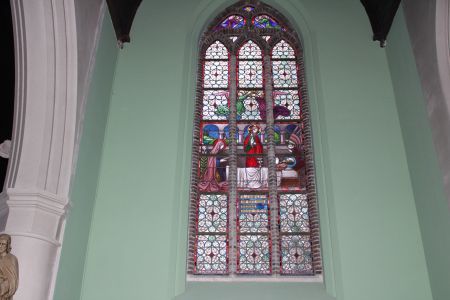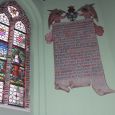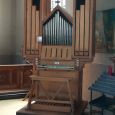Church | 1926 | Neogothic | Catholic Church





Map
Opening hours
01 January - 31 December
Mon 8.00 - 18.00
Tue 8.00 - 18.00
Wed 8.00 - 18.00
Thu 8.00 - 18.00
Fri 8.00 - 18.00
Sat 8.00 - 18.00
Sun 8.00 - 18.00
Religious offices
Description
Westrozebeke is mostly known for the Battle of Roosebeke (1382), where the Flemish suffered a crushing defeat against the French. According to legend a red wire around the village has protected the inhabitants from the war. This wire was secured in seven places. These days the seven little chapels of the Procession still refer to those places. Ever since this battle, Our Lady of Roosebeke has been widely idolized.
Little is known about the construction history of the church, but it is presumed that there already was a little stone church in Westrozebeke as early as the 12th century. In 1566 part of the church was damaged during the Iconoclastic Fury. Around 1740 it was decided to pull down the contemporary church and replace it by a new building. It is this new church that was completely destroyed during World War I. The current church is a reconstruction built in the 1920s.
In the choir we can find the statue of Our Lady of Roosebeke. This little sculpture has brought a great deal of pilgrims to Roosebeke over the centuries. The original statue is said to have been transferred from a forest chapel to the church in 1383, after the Battle of Roosebeke. However, it was destroyed during the Iconoclastic Fury (1566). Luckily, the new statue (16th century) was brought to safety during World War I and found temporary refuge in the Saint-Michael’s church of Roeselare during the reconstruction of the church.
The white plastered wall of the northern choir contains a fresco: a parchment crowned with a shield, showing the allegorical representation of Roosebeke, held by two angels.
The glass windows in the southern choir are dominated by Saint Joseph, the ones in the northern choir by Our Lady of Roosebeke.
Photos
Remarkable elements
Choirs
The white plastered wall of the northern choir contains a fresco: a parchment crowned with a shield, showing the allegorical representation of Roosebeke, held by two angels. The glass windows in the southern choir are dominated by Saint Joseph, the ones in the northern choir by Our Lady of Roosebeke.Sculpture of Our Lady in Westrozebeke
After the original sculpture from the 14th century was destroyed by the iconoclasts in 1566, a few years later a new oak sculpture (the current) was made of precisely 1 metres in height. It was polychromed and was decorated in several different ways during the following centuries. After World War I it was installed in the newly built church. Originally, on the left side altar, later high above the head altar and since 2002 on the location where it had always stood during World War I.Organs
In the year 1936 Jules Anneessens from Menen build the organ of the rood loft. It has two manuals, a foot manual and 18 pipes. The action is pneumatic. In 1987 there was an elaborate maintenance done to the organ with a slight adjustment to the disposition. Yearly, the organ is being maintained by Paul Andriessen.In front of the church stands a choir organ built in 1980 by Philippe Busschaert from Kortrijk. It has a mechanical action, one manual and an attached foot manual. It counts 6 pipes.
In addition to their function in the liturgical ceremonies both organs are being played by international renowned organ players during organ concerts in the church.
Stained-glass windows
On the left window in the northern choir stands Philip the Bold, duke of Burgundy and count of Flanders with his wife Margaret of Male who in 1384 came to Westrozebeke. They held a procession in gratitude for the support of Our Lady during the Battle of Westrozebeke in 1382.On the right window hangs a little chapel with Our Lady of Westrozebeke on a tree. In the distance one can see the church tower of Westrozebeke.
The stained-glass window of the southern choir depicts a blessing Christ at the deathbed of Joseph. Mary reads while she is kneeling at the foot end and next to her a lily is depicted as a symbol of purity. At the head board stands a praying angel.
Crucifix with Jesus ressurected
As a result of the redecoration of the choir and the displacement of the statue of Our Lady, the idea starts to hang a giant crucifix above the altar. At the request of the pastor, it was decided to go for a cross with Christ resurrected on it, which was also a first for Flanders. The order to make this was given to the art sculptor Donaat Vanoverschelde from Zarren.“Ex-voto” or the painting of Sussex
On the 24th of March of 1916 the packet boat “Sussex” of Folkstone in England sailed to Dieppe in France. On board were 320 passengers, mostly refugees – including 11 inhabitants of Westrozebeke. Around 3 p.m. the German submarine fired a torpedo towards “Sussex”. The torpedo destroyed the front of the ship. Some crew members jumped into the sea. Around midnight on March 24th/25th of 1916 (celebration of the message of Our Lady) came the French fishing boat, the “Marie-Thérèse” which saved 192 of the passengers. All eleven inhabitants from Westrozebeke who had prayed to Mary were saved.Out of gratitude for Albert Debaes, one of the rescued, in 1934 this painting was made from a photo that appeared in the French daily “The Mirror”. This painting was carried yearly by the rescued in the procession of Mary.
Art Deco candle sticks and light fixtures
On the high altar four copper candle sticks stand with the shield of the city Menen. Each candle stick is dated “1935” on the foot at the back. Each candle stick leans on three lions couchants. To both sides of the altar stand two big copper candle sticks.
The larges candle sticks with blue incorporated “stones” have nineteen electric candles with the inscription “Meenen 1937” under the coat of arms of Menen. Both the big as the small candle sticks are decorated with stylized vine leaves and bunches of grapes in art deco style. These candle sticks, but also others located elsewhere in the church, are gifts from the pilgrims of Menen.





















